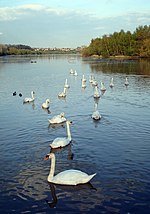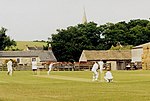New Fryston

New Fryston is a small former coal mining village in Castleford, West Yorkshire, England, located in a river bend on the south bank of the River Aire. The colliery opened in the 1870s in the grounds of the now-demolished Fryston Hall and was named Fryston, and the village was built in the 1880s to house some of the miners. At its peak, the pit employed around 1,300 miners. It closed in 1985. After the pit's closure, the colliery buildings were demolished.The settlement is also called Fryston village.In 2005, a re-generation programme called the Castleford Project, carried out a number of re-developments in Fryston including what turned out to be a controversial new Village Green; these re-developments were the subject of a series of television programmes on Channel 4.
Excerpt from the Wikipedia article New Fryston (License: CC BY-SA 3.0, Authors, Images).New Fryston
Brook Street, Wakefield
Geographical coordinates (GPS) Address Nearby Places Show on map
Geographical coordinates (GPS)
| Latitude | Longitude |
|---|---|
| N 53.738722 ° | E -1.313343 ° |
Address
Brook Street
Brook Street
WF10 2PL Wakefield
England, United Kingdom
Open on Google Maps








